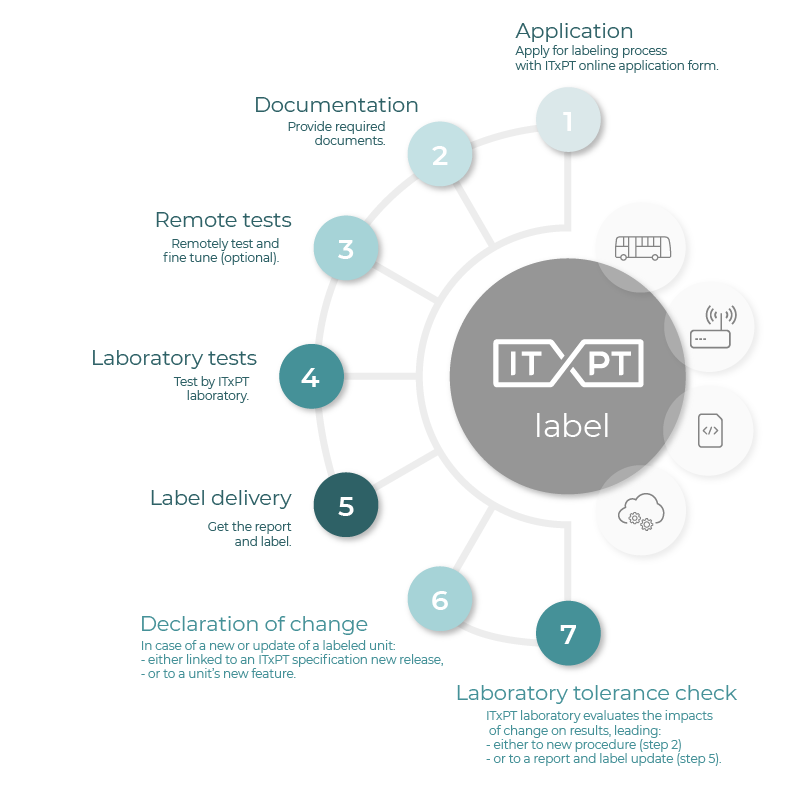ITxPT Labeling
Before a product can be granted the ITxPT label, it must pass extensive tests conducted by the ITxPT laboratory. This evaluation process ensures that the product complies with the ITxPT technical specifications, ensuring interoperability and a smoother integration process.
The ITxPT technical specifications can be found in the ITxPT documentation center, which you can access by registering free of charge.
Any supplier can apply for the ITxPT label, which certifies that the vehicle, equipment, software or service complies with ITxPT standards and specifications. The ITxPT label is granted after completion of the labeling process defined below. It is mandatory to complete all the steps of the labeling process.
The label can be applied to a:
- vehicle
- module hardware and/or module software
- back-office
ITxPT labeling is offered through a clear step-by-step process supported by the ITxPT laboratory. It should be noted that tests only evaluate technical compliance and do not in any way assess functional performance.
The label process can begin as soon as the applicant is ready, in accordance with the laboratory’s workload schedule. The maximum time limit for the procedure is three months after the payment date. The laboratory is closed from mid-July to the end of August. You will receive a quotation once we have received your label request. More details are available on prices page.

Label Procedure
1. Application form
Once you have implemented the ITxPT specifications in your product, the first step in the ITxPT labelling process is to complete the ITxPT label application form. Note that the label process is not a development phase but a compliance test.
The ITxPT laboratory responds to applications within two week, except during the annual closure (July to mid-August).
Note that as many application forms as vehicle type or module range have to be filled in.
Pricing info
Before starting any step further, you will have to pay a fee or use a credit (members). The pricing info for labeling module or vehicle can be found on the pricing page. A quote is sent once we have received your label request.
Timing
By applying, you commit to complete the labeling process within a maximum of 3-month time (it can take only few days depending on your readiness level and required man-days on your side).
2. Documentation
The preliminary step consists of providing documentation about the unit to be labeled.
- Vehicles: diagrams, CAO views, pictures…
- Modules (hardware and/or software): datasheet, user manual, and EC declarations, E-marking statement when applicable.
- Back-offices: implementation choice, selected profile.
3. Preliminary remote tests (optional)
For module suppliers and back-office editors, preliminary tests with the ITxPT laboratory can be performed to help in fine-tuning the module software before final tests (next step).
Such preliminary tests can be performed remotely, on the ITxPT technical platform managed by the ITxPT laboratory.
The maximum duration of this step is limited to one day of remote testing by a test engineer.
4. Final tests
Final tests are performed by the ITxPT Laboratory in a secured and monitored environment.
The maximum duration of this step is limited to one day of physical testing by a test engineer.
- Vehicles: once ready, the vehicle is checked at the manufacturer’s site by the ITxPT Laboratory. Tests are run with the ITxPT mobile laboratory tools to check compliance with the ITxPT specifications.
Please note that the ITxPT test engineer’s travel expenses are at your expenses (excluded from labeling fees). - Modules (hardware and/or software): once ready, the module is installed on the ITxPT platform located in the ITxPT laboratory located in Western Europe. Iterative tests are run to check the compliance with the ITxPT specifications.
Please note that you are responsible for organising and paying for the delivery and return of your module (excluded from labeling fees). - Back-offices: once ready, the back-office must be connected to the ITxPT platform on time as scheduled. Iterative tests are run to check compliance with the ITxPT specifications

5. Report and label
5.1. Report
Once all tests have been run, a test report is delivered by ITxPT.
The test templates describe the test report used to validate compliance with the related specification.
These templates can be found in test template section (access restricted to Principal and Strategic Members).
Reports include the list of tests run in step 4, for which a result is generated for each line:
- compliant
- not compliant
- not tested
- not applicable
5.2 Label
The ITxPT label can be applied to vehicles, modules (hardware or software) or back-offices, provided that:
- they comply with the ITxPT specifications,
- they comply with TS13149 (modules),
- they comply with SIRI, NeTEx, TiGR (back-offices)
- they have been tested by the ITxPT Laboratory,
- a related test report has been delivered by the ITxPT laboratory.
Vehicle manufacturers, module suppliers or back-office editors who have successfully received the report and have been granted the ITxPT label are entitled to apply the label logo on their tested units and be included in the ITxPT catalogue.
6. Declaration of change (optional)
In case of an update to a labelled unit, either linked to an ITxPT specification new release or to a supplier new feature, the supplier must fill in a declaration of change. This declaration of change lists in detail the impacts of change compared to the label report.
Use the online Declaration of change form to declare a change to a labeled unit:
7. Declaration of change evaluation
The ITxPT laboratory checks the declarations of change and can propose either the start of a new label process or an update to the label report, depending on the impacts of the change regarding the tolerance frame.
